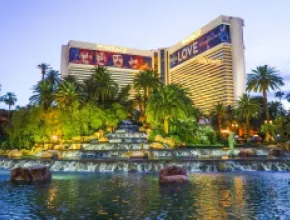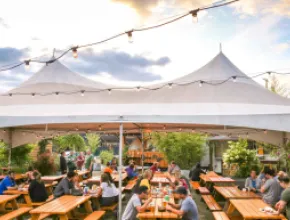Think of California and images of beaches, mountains, the Wine Country, celebrities and lots of sunshine might come to mind first. But farms? Maybe not, but—if economic activity is a gauge of importance—they should be high on the list.
California is the major agricultural state in the U.S., producing nearly half of its fruits, nuts and vegetables. That translates into a farm-fresh bounty of food, the basis of famous California cuisine that has become part of the Golden State’s allure.
Eating well, enjoying seasonal, organic fruit and vegetables, artisan cheese and other local food products is a draw for visitors, says Caroline Beteta, director of the California Travel and Tourism Commission.
“Food and wine is definitely up there when you look at the reasons people come to California,” Beteta says. “We’ve got nine of the 10 top-producing agriculture counties in the U.S. People who want to experience a food culture and eat well know that they will have an overall good dining experience here in California.”
With visitors hungry to indulge in the state’s abundance, increasing opportunities for food- and culinary-related activities are popping up all over California.
In the Napa Valley, bucolic Long Meadow Ranch (www.longmeadowranch.com) offers group tours of its six acres of heirloom vegetable gardens and fruit orchards. The ranch, which raises special breeds of grass-fed cattle, pigs and egg-laying chickens, was the first Napa-area outfit to produce wine and olive oil out of the same building—a rammed-earth structure designed by renowned architect William Turnbull.
Going Local with S.F. Chef Douglas Monsalud
“Groups seek us out because of our diversity,” says Aaron Feavor, ranch manager. “You can tour the winery, including the caves, fermentation room, crush pad and olive mill, or you can tour the ranch property and see the vineyards, olive orchards and animals. Or you can tour them both. We also offer custom tours that can include the gardens and the bees.”
After the tour, groups have a three-course lunch prepared from farm ingredients and paired with the ranch’s wines.
In San Francisco, good food and memorable dining have become synonymous with a visit, says Joe D’Alessandro, president and CEO of San Francisco Travel Association.
“There’s probably only one other U.S. city, New Orleans, that comes as close to San Francisco as a foodie destination.”
The towering Ferry Building on the waterfront has become a de rigueur stop for anyone interested in eating well. Some of Northern California’s premier food artisans are found here, including Cowgirl Creamery (www.cowgirlcreamery.com), which offers group tours and cheese tasting tours at its Ferry Building shop and also at its Sonoma and Marin County facilities.
Participants are led through a tasting of three cheeses by a cheese expert who discusses the selections and cheese’s role in agriculture.
The Ferry Building and its renowned farmers market, considered the best in Northern California, was the first place that Edible Excursions’ Lisa Rogovin (www.edibleexcursions.net) started exploring with groups on tours.
Her programs have become so popular that Edible Excursions expanded to the city’s ethnic enclaves, including the Mission District, which is heavily Latino and filled with taquerias, bakeries and Hispanic grocery stores, and Japantown, the historic Japanese neighborhood lined with food markets and sushi and noodle restaurants.
“The thing to do in San Francisco is eat,” Rogovin says. “You don’t want to waste a minute while you’re here, so on my private group tours we focus on those special places that out-of-towners are less likely to find.”
Rogovin’s group options include a hands-on truffle-making session at La Cocina, a nonprofit “incubator” for new food companies, a sample of homemade pie at a shop where the fruit used is picked by high school students at a farm outside the city and visits to her favorite taquerias.
Molly Fuller, president of San Francisco’s Hands On Gourmet (www.handsongourmet.com), says cooking parties with local chefs are popular with groups visiting the city because of its well-known food culture.
“We offer a hands-on cooking experience alongside professional chefs that gives people the opportunity to be a part of the food and wine community here,” she says. “Most of our ingredients are locally sourced, and we believe in the importance of working with local producers, which is really easy here because of the abundance of delicious food that is grown within 150 miles of San Francisco.”
Of the company’s group offerings, the sit-down dinner is popular because it is “classic, straightforward and delicious,” according to Fuller.
“Over the course of three hours, the group is separated into mini cooking groups, each one cooks alongside a professional chef and then sits down to relax and eat what they have made,” she says.
A stone’s throw from the city’s Moscone Center, Press Club (www.pressclubsf.com) opened two years ago as a unique 7,000-square-foot event venue showcasing California wine and food and offering private group seminars on wine pairings.
“All of the delicious wines and beers that we offer are all sourced from Northern California’s best and most exclusive wineries and small batch breweries,” says Walker Allen, events director. “Just about every region and microclimate in Northern California is represented in our wine list—a virtual tasting tour of this gorgeous state. In addition, all of the food we offer at Press Club is designed to pair with our wines.”
At Fisherman’s Wharf, San Francisco food history is presented at Boudin Bakery (www.boudinbakery.com), which doubles as an event venue. Groups can visit the museum and take the bakery tour, learning about the city’s history through the evolution of its most famous loaf of bread.
Attendees can have a hands-on food experience with new off-site group education programs offered by Santa Cruz-based Love Apple Farms Gardening and Cooking Educational Center (831.566.1591; www.loveapplefarms.com), the exclusive farm partner for the two Michelin-starred Manresa restaurant in Los Gatos, Ca. The off-site series is an extension of the workshops currently offered at the farm. Planners can now have Love Apple Farms present programs to their groups on-site, with class options such as Container Vegetable Gardening, Home Preserving and Break-Baking Basics.
In Central California, visitors can explore the area made famous by John Steinbeck and known as the “Salad Bowl of the World.”
On AgVenture Tours (www.agventuretours.com) programs, groups learn about the history and wealth of the Salinas Valley agriculture industry. Participants are taken into the vast fields to observe harvesting, irrigation, planting and organic farming of crops such as lettuce, broccoli, artichokes, strawberries and grapes. An array of customized wine and agricultural tours are available.
Santa Barbara’s Market Forays (www.marketforays.com) guides groups on culinary tours in the food-rich coastal area known as “California’s Rivieria.” After collecting ingredients at a fish market, the farmers market, local shops C’est Cheese and Our Daily Bread, French-born foodie and guide Laurence Hauben teaches participants to prepare dishes they can make at home. The experience concludes with a lunch paired with local wines.
New on the Santa Barbara food scene is Craving Adventures (www.cravingadventures.com), run by Caroline Connor and Eve Sommer-Belin, two locals passionate about food, wine and outdoor adventure. They create customized itineraries based on the “palate preferences” and interests of groups. Offerings include olive oil tastings, farmers market visits, chef-led cooking classes and sampling some of Santa Barbara’s best eateries.
In Los Angeles, the vast diversity of cultures and dining experiences is a focus of culinary adventures.
Melting Pot Tours (www.meltingpottours.com) is led by Lisa and Diane Scalia, two sisters and Los Angeles natives who launched the company in 2008 to share their favorite local food experiences with visitors.
The company customizes private food-tasting walking tours for groups in East Los Angeles’ Latino neighborhood, the Third Street Farmers Market and Pasadena.
“Our food tours are appealing, as they offer an interactive experience for each member of a group,” says Lisa Scalia, co-owner. “The size of our tour groups is limited to no more than 15, so each person in the group is able to interact directly with the tour guide and with other tour participants. Since there is both information and food shared throughout each of our tours, we feel it appeals to a broad spectrum of people—foodies, history buffs, cultural enthusiasts.”
The company’s Old Pasadena tour is the most popular for groups, according to Scalia.
“This tour can be customized most easily as to time of day and length of tour, and is also the most ‘food-friendly’ tour for those with food allergies and dietary restrictions,” she says.
Earlier this year, Melting Pot Tours hosted a group of 50 on an evening food tour in Old Pasadena that was customized.
“Rather than make 10 stops, we limited the stops to three, with each stop serving one course (appetizers and wine, dinner and wine, dessert and coffee),” Scalia says. “All of the members of the group were able to dine together at each stop, but they were broken up into smaller groups to enjoy the narrative portion of the tour. It was extremely well received and thought to be quite innovative. Rather than a group dinner or even just a progressive dinner, the participants got a full meal with time between courses to digest their food, and they were entertained between stops with the history, culture and folklore of Old Pasadena, which they truly enjoyed.”






